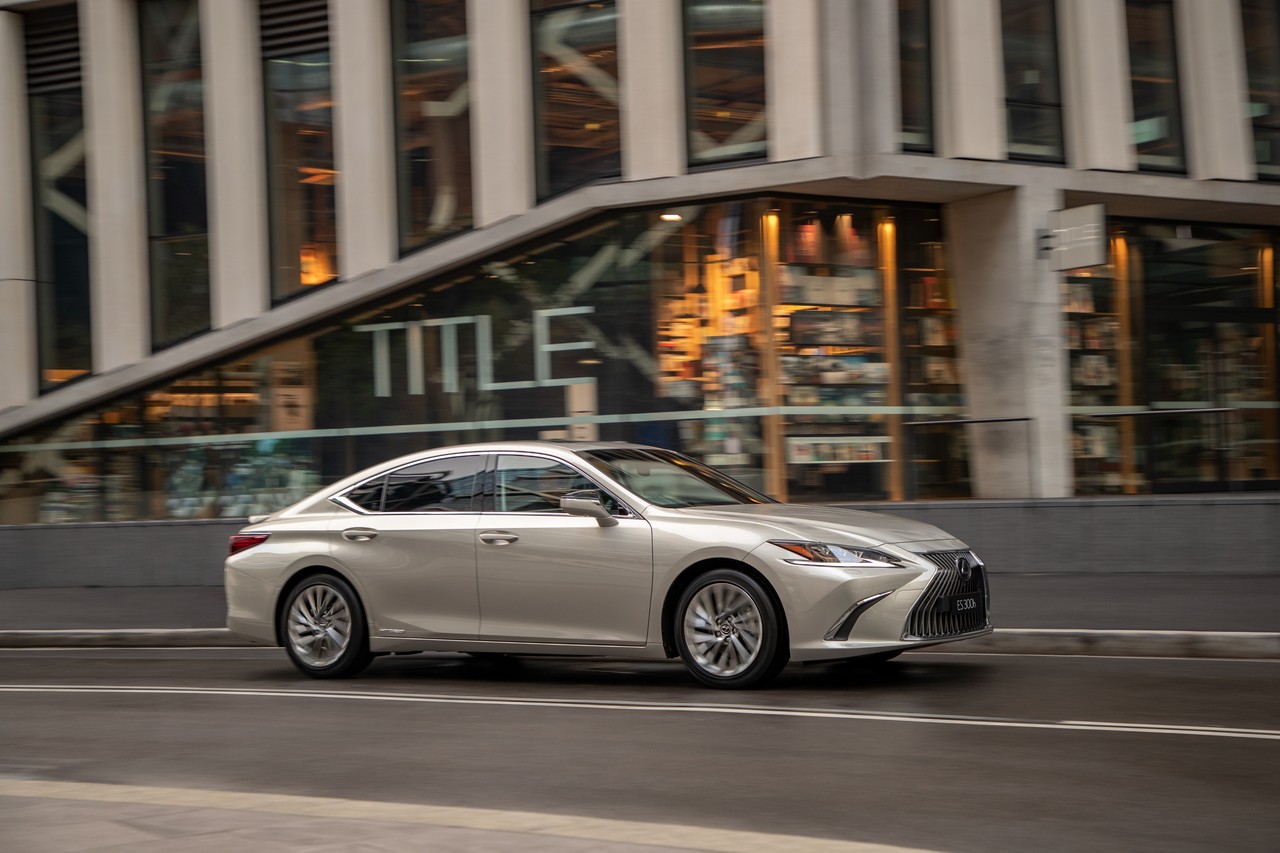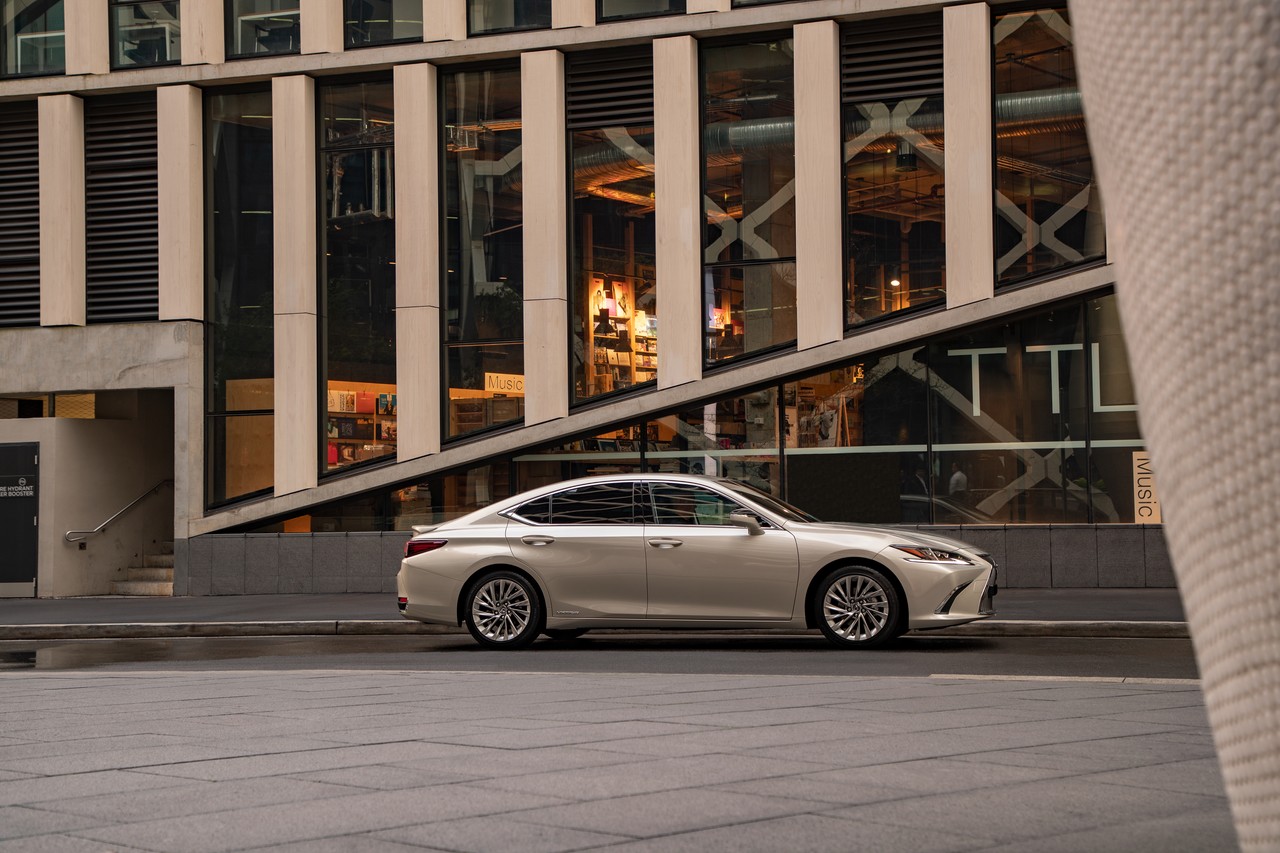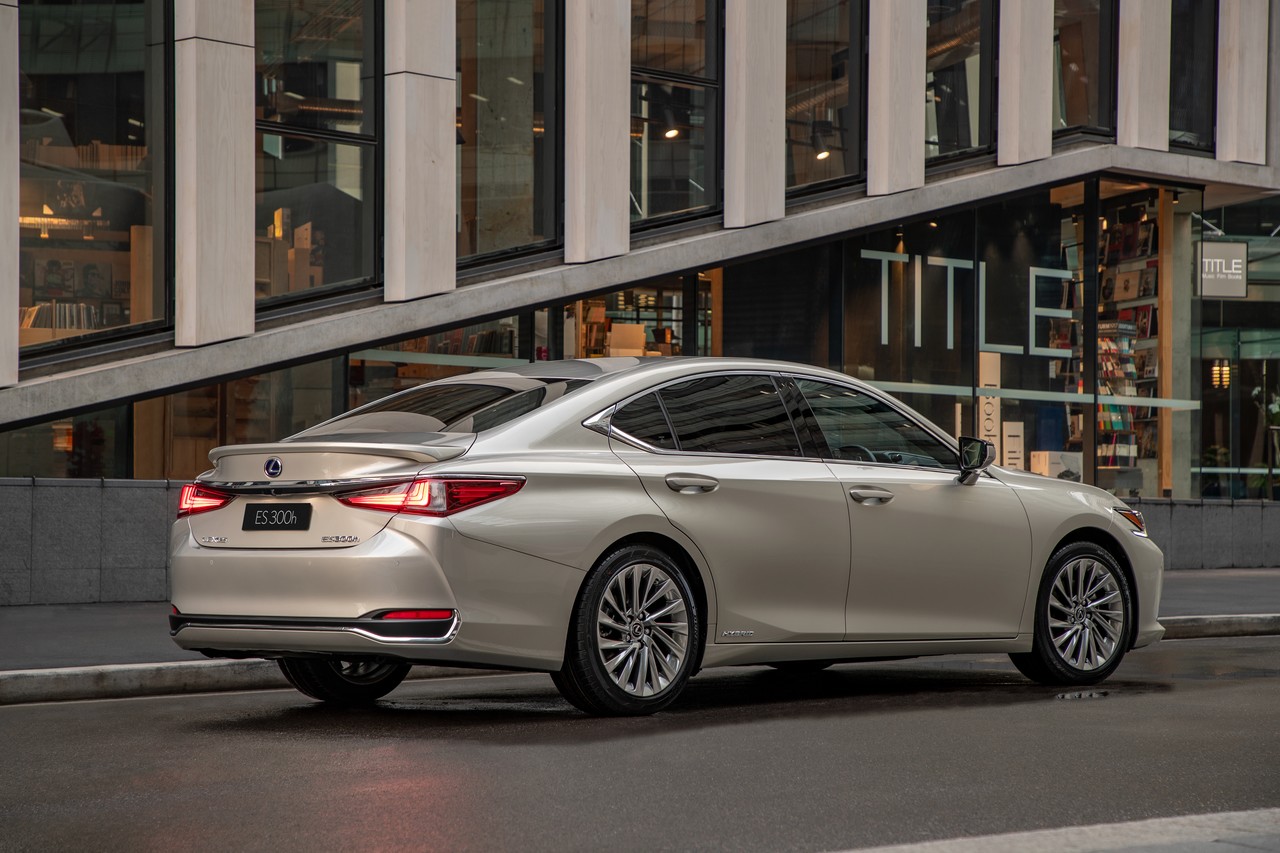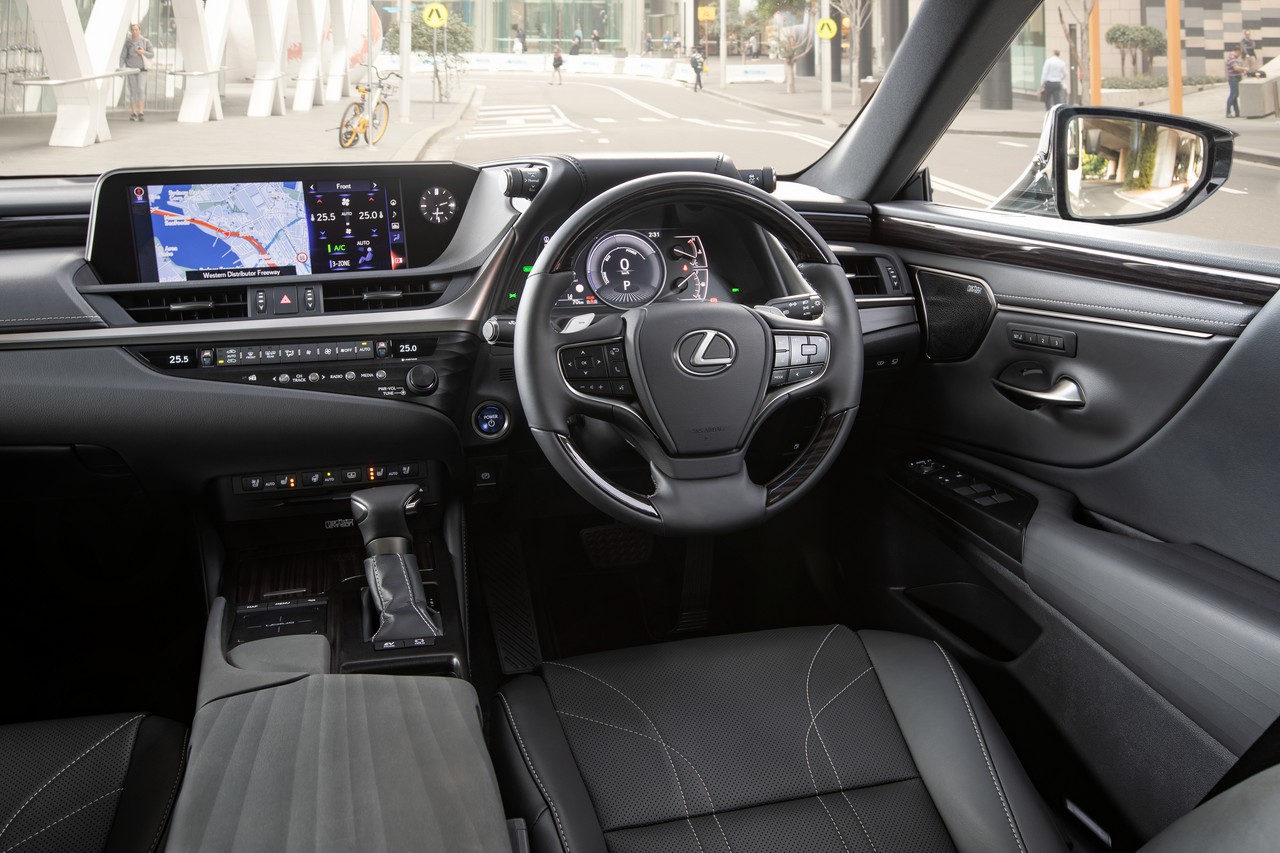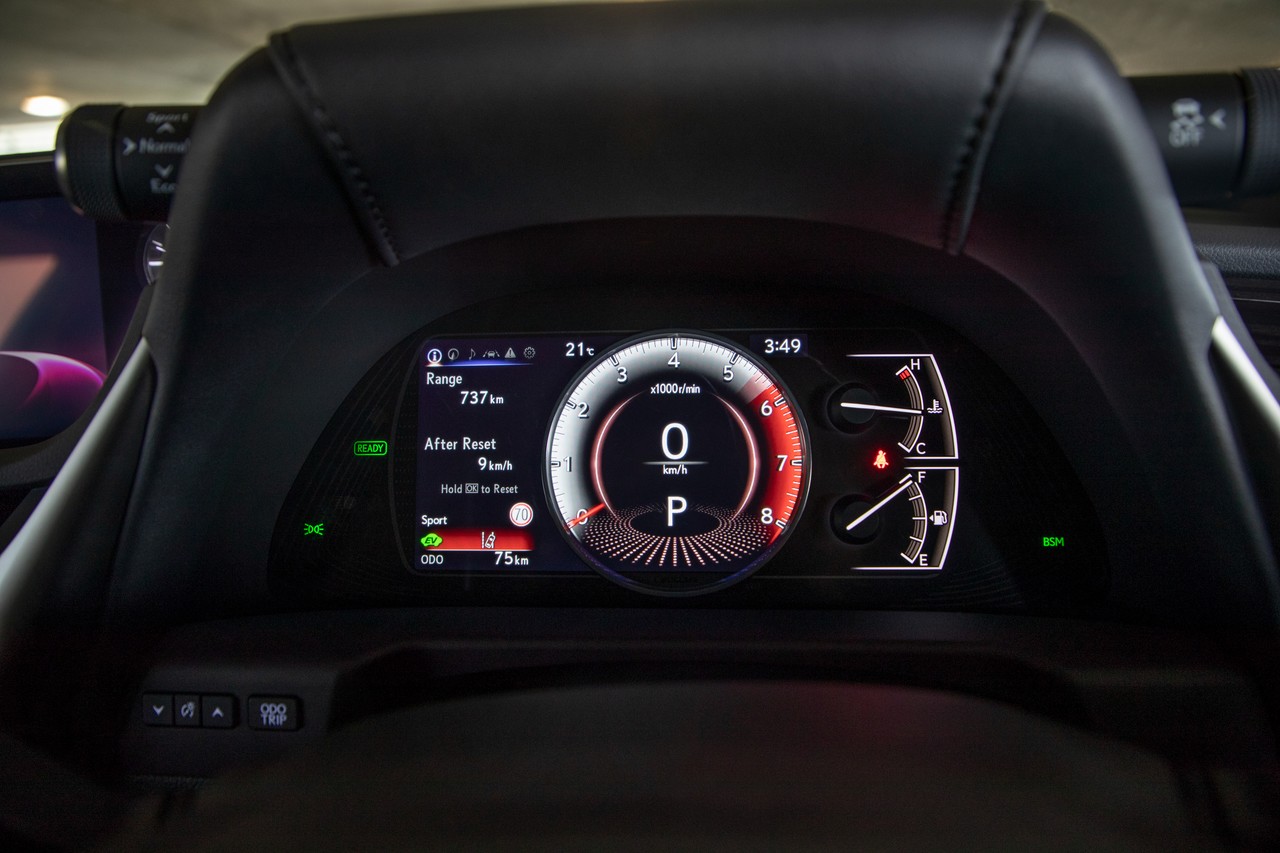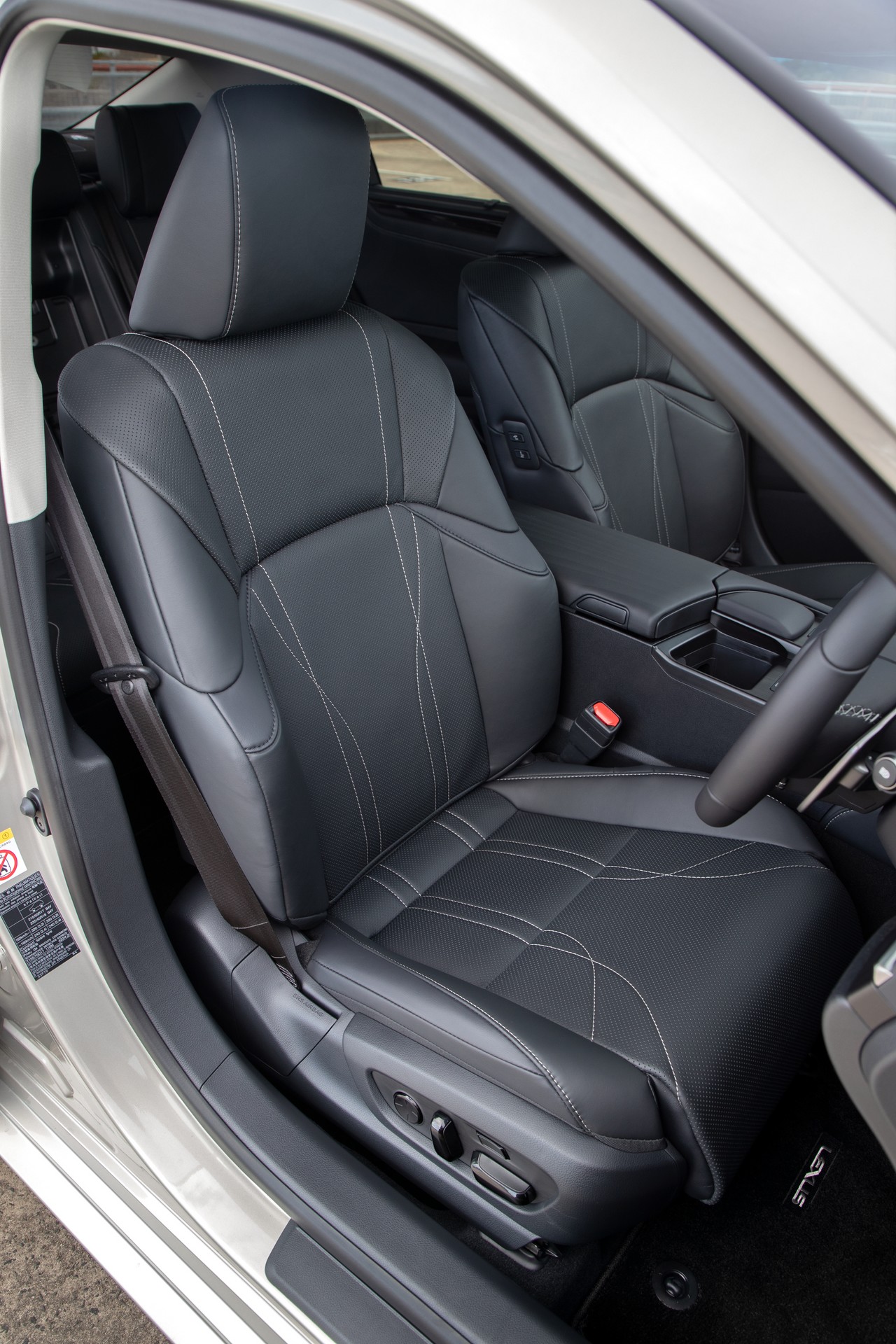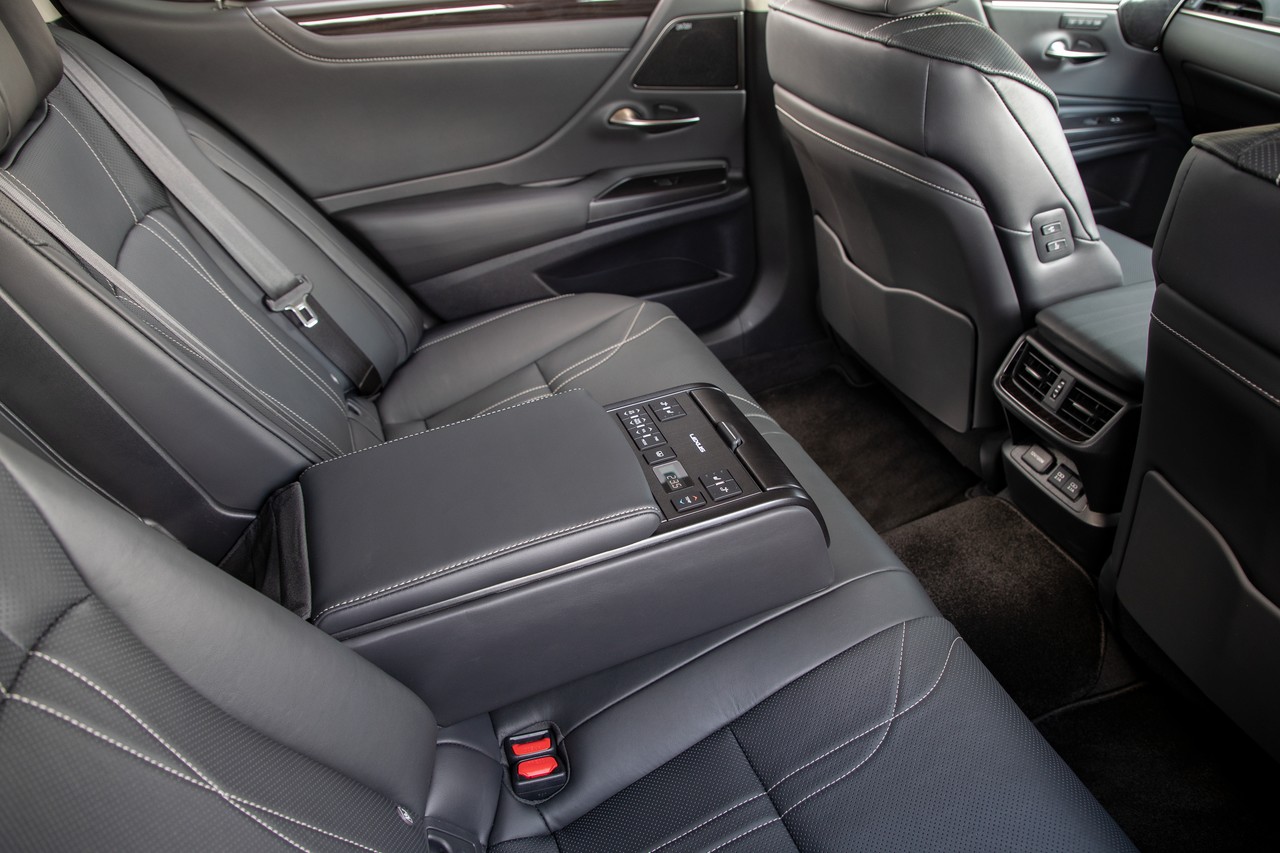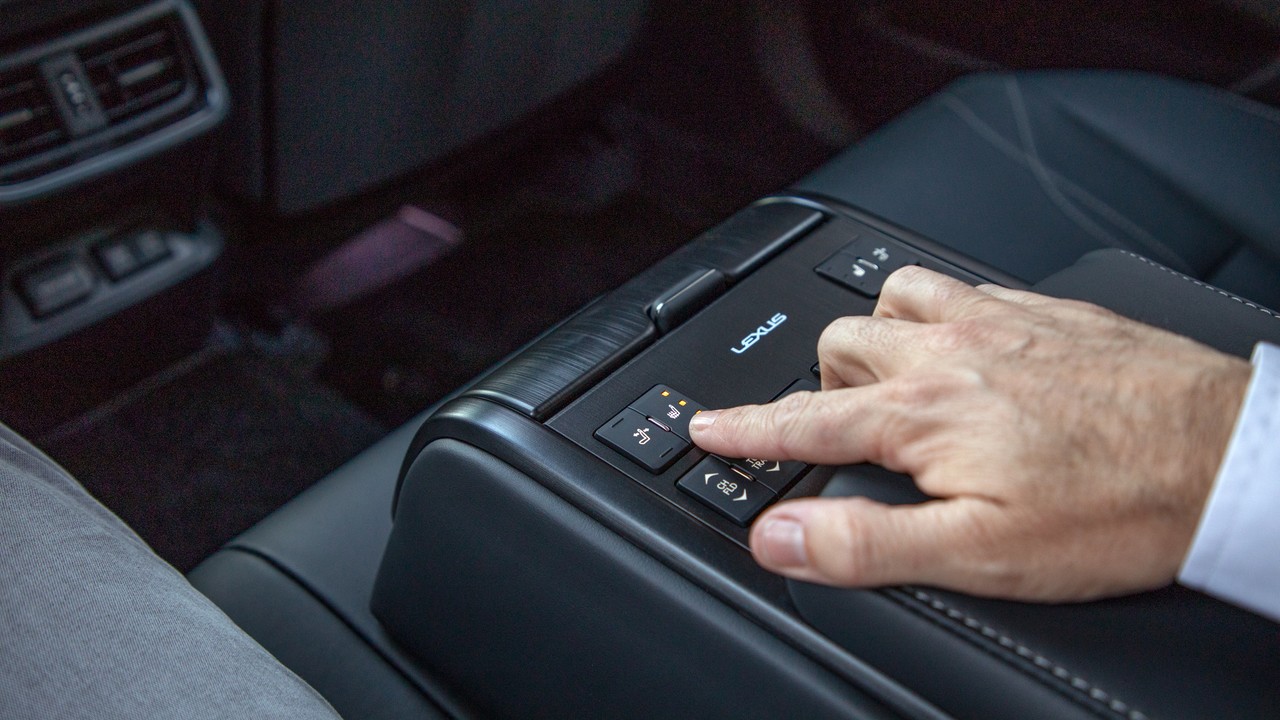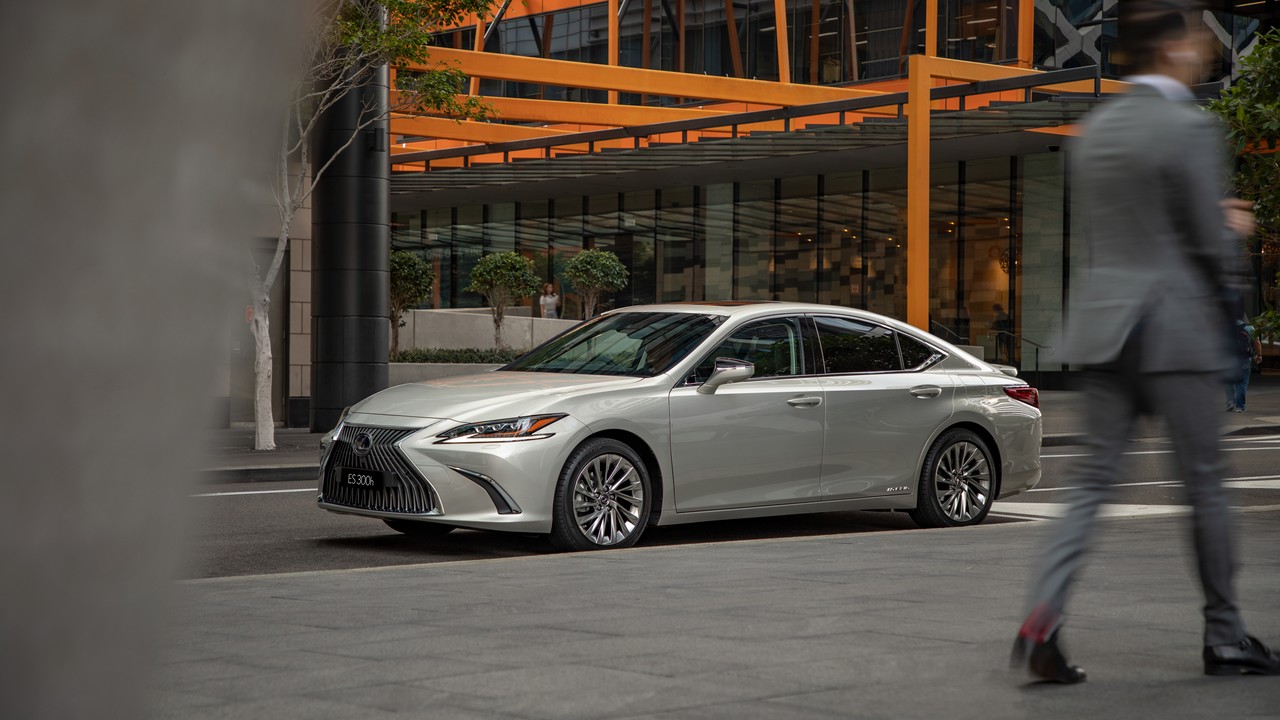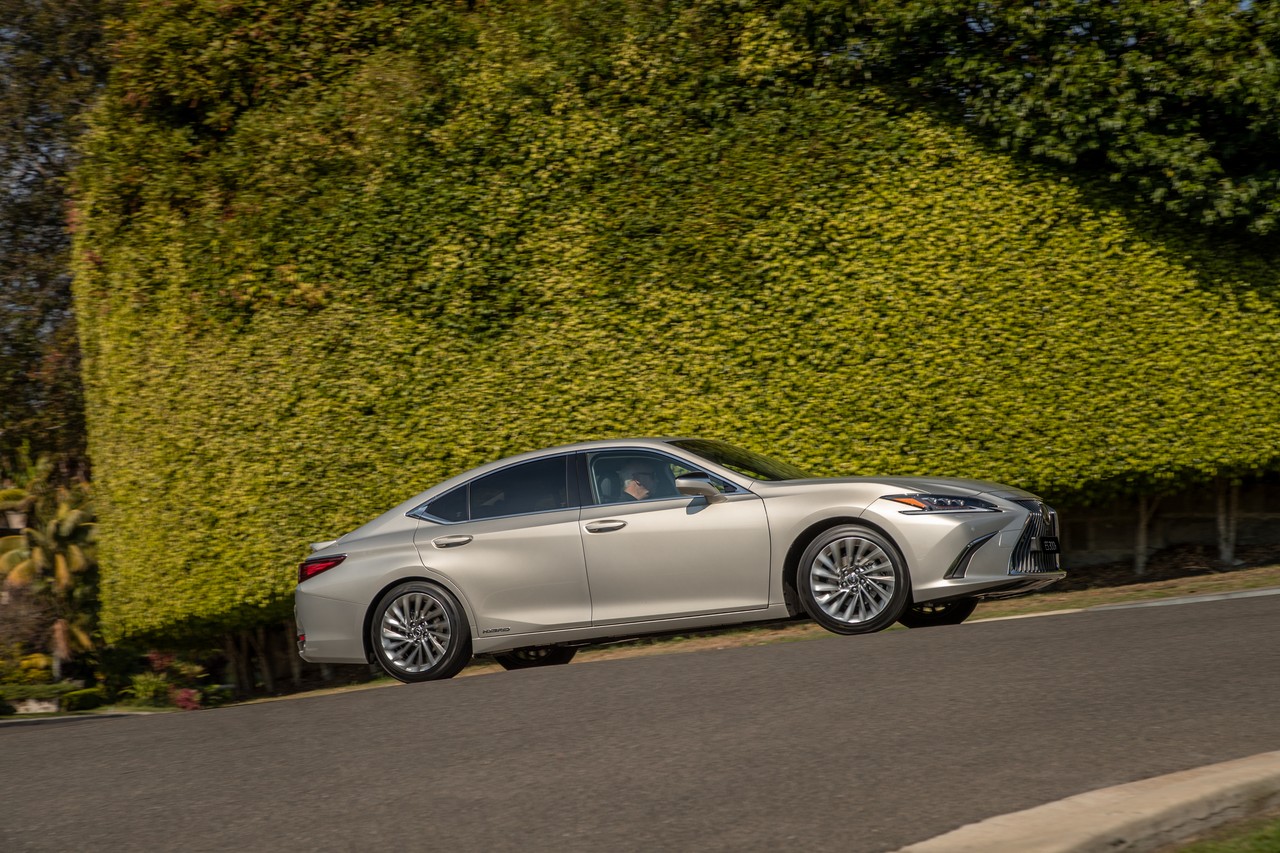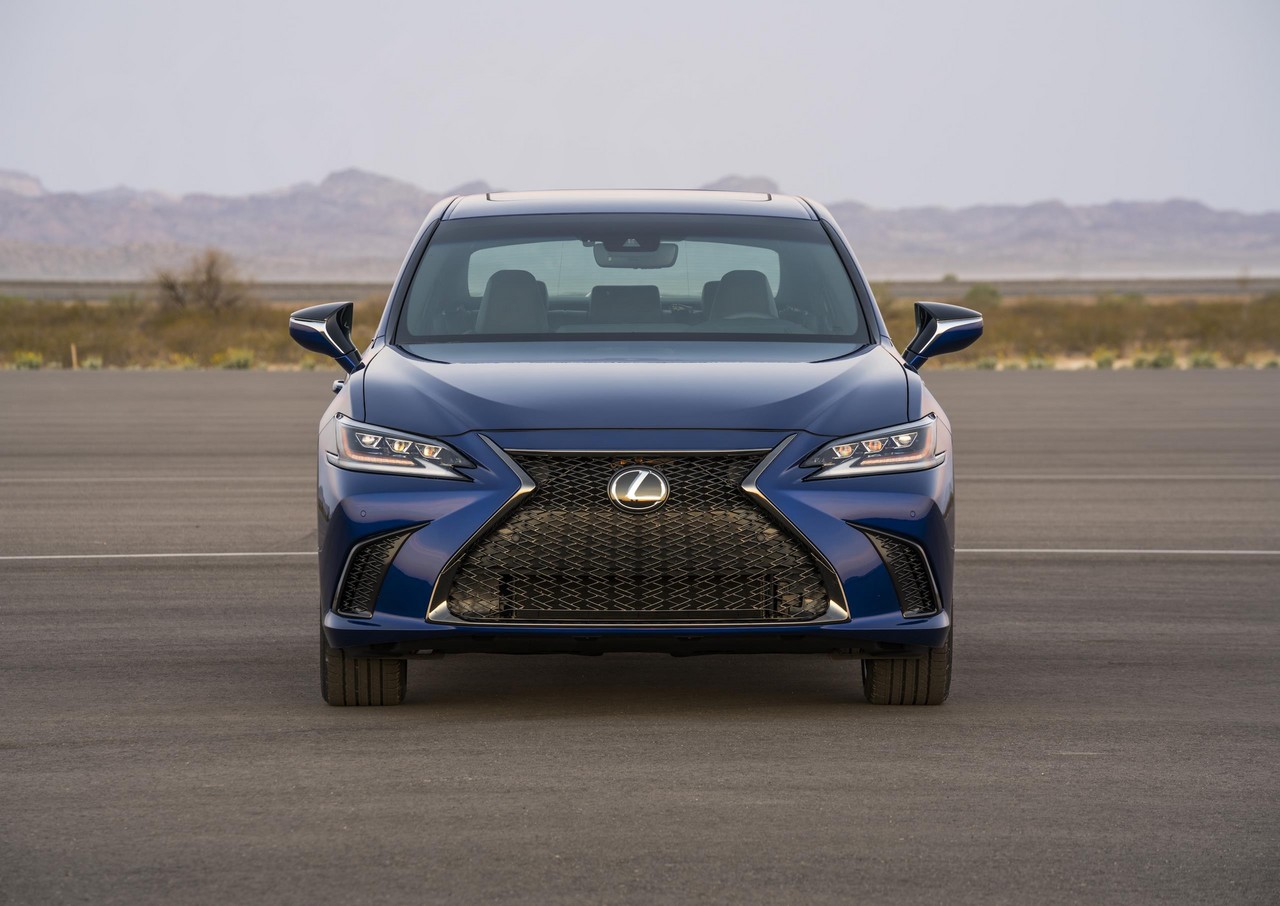
- Comfortable ride
- High standard of interior fit and finish
- Electric motor provides strong acceleration from rest
- Fuel-efficient hybrid powertrain is generally quiet…
- … but, e-CVT programming produces high engine speeds at wide open throttle
- At highway speeds, wind noise and tyre roar are conspicuous
- Price premium to related Toyota XV70 Camry Hybrid
- Front-wheel drive isn’t as engaging as rival rear-wheel drive models
- Brake pedal lacks initial response
- Poor rear headroom
- Rivals have bigger boots
- ‘Luxury’ variants miss out on safety equipment of ‘Sports Luxury’ variants
Overview
Released in Australia in September 2018, the Lexus XV70 ES was a large, front-wheel drive sedan. Manufactured in Fukuoka, Japan, the Lexus XV70 ES range for Australia consisted solely of the ES 300h which was offered in Luxury and Sports Luxury variants. As such, Australia did not receive the ES 350, ES 250 or ES 200 models.
In October 2019, the range was expanded with the release of the Lexus ES 300h F Sport.
A25A-FKS engine and electric motors
Like the Toyota XV70 Camry Hybrid , the Lexus XV70 ES 300h was powered by Toyota’s A25A-FKS engine. Within its die-cast aluminium alloy cylinder block, the A25A-FKS engine had 87.5 mm bores and a 103.4 mm stroke for a capacity of 2487 cc. Other attributes of the A25A-FKS engine included its aluminium alloy cylinder head, double overhead camshafts (chain-driven), roller rocker arms, four valves per cylinder and compression ratio of 14.0:1. Key features of the A25A-FKS engine included:
- Toyota’s ‘D-4S’ fuel injection system which combined direct injection (via six-hole nozzle injectors) with traditional port injection for more precise air/fuel mixing under low and medium load conditions;
- A 41 degree angle (approximately) between the intake and exhaust valves;
- For the intake valves, VVT-iE camshaft timing which used an electric motor to vary the VVT-i controller for camshaft advance or retard. In contrast, the exhaust camshaft haDda conventional hydraulic VVT-i system in which the camshaft timing oil control valve controlled a spool valve that enabled hydraulic pressure to be applied to the advance or retard side of the VVT-i controller. In response, rotation of the VVT-i controller vane sub-assembly (relative to the timing chain sprocket) varied valve timing. The exhaust camshaft also had a mid-position lock mechanism; and,
- A trochoid-type continuous variable capacity oil pump.
AustralianCar.Reviews understands that the A25A-FKS engine has two counter-rotating balance shafts.
In hybrid powertrains such as the Lexus XV70 ES 300h, the A25A-FKS engine was combined with two electric motor generators (MG1 and MG2), though only MG2 Was used to power the front wheels. Compared to the Lexus XV60 ES 300h , changes for the XV70 ES 300h included:
- A more compact transaxle due to a multi-shaft layout in which MG1 and MG2 were located on a different axis (rather than sharing a single axis). By using a parallel axis gear, instead of the previous planetary gear, losses from the gear train were reduced;
- The redesigned nickel-metal hydride (Ni-MH) battery had newly developed ‘Hyper-Prime Nickel’ technology to improve performance while reducing size and weight. The battery had a nominal voltage of 244.8 V (204 cells, 1.2V/cells), a capacity of 6.5 ampere hours and a system voltage of 650 volts;
- Improvements in the conversion efficiency of the power control unit (PCU) and the transaxle/electric motor which reduced energy losses by about 20 per cent. Furthermore, improvements to the cooling system efficiency were claimed to reduce energy losses by around 10 per cent;
- A lighter and more compact PCU due to the integration of micro-controllers and adoption of a new power stack structure which enabled it to be positioned above the transaxle; and,
- A revised DC-DC converter with optimised output control – including the conversion to AC power – that reduced overall power consumption.
The A25A-FKS engine had a thermal efficiency of 41 per cent in hybrid vehicles.
For Lexus XV70 ES 300h, the driver could select from three drive modes: Eco, Normal and Sport. When using Eco mode, the Auto Glide Control (AGC) function improved fuel efficiency by calculating an efficient coasting logic. Specifically, the system limited the loss of vehicle speed to provide smooth engine braking and allowed the vehicle to coast to rest.
Over the combined ADR 81/02 test cycle, fuel consumption for the Lexus XV70 ES 300h was 4.6 litres per 100 km.
| Motor | Trans. | Peak power | Peak torque | |
|---|---|---|---|---|
| ES 300h | 2487 cc A25A-FKS petrol I4 | CVT | 131 kW at 5700 rpm | 221 Nm at 3600-5200 rpm |
| 650-volt AC motor generator | 88 kW at 4500 rpm | 202 Nm at 0-1500 rpm | ||
| Combined | 160 kW | N/A | ||
Body and dimensions
The Lexus XV70 ES was based on Toyota’s new Global Architecture K (GA-K) platform which provided a lower centre of gravity, hip point, shoulder line, roof line and bonnet height. Features of the Lexus XV70 ES chassis included:
- The increased use of ultra-high-tensile steel and hot stamping materials (which also reduce mass);
- At key junctures, laser screw welding with a greater number of weld points;
- A special urethane adhesive where the windscreen and rear window met the body;
- Additional gussets for the centre pillars;
- Closed cross-section construction for the front suspension tower brace;
- A new rear body frame of annular construction which included a V-brace behind the rear seat; and,
- Additional braces for the rear suspension to improve lateral rigidity.
According to Lexus, the body of the XV70 ES was 30 per cent stiffer than the Lexus XV60 ES. Kerb weight for the Lexus XV70 ES 300h ranged from 1680 kg to 1740 kg.
Compared to the Lexus XV60 ES , the Lexus XV70 ES was 81 mm longer (at 4976 mm), 43 mm wider (1864 mm), 5 mm lower (1445 mm) and had a 48 mm longer wheelbase (2870 mm); its drag co-efficient was 0.26 Cd. Since the hybrid battery pack was positioned under the rear seat, boot space for the Lexus ES 300h was 454 litres.
While the GA-K platform is shared with the Toyota XV70 Camry Hybrid , the Lexus XV70 ES was 71 mm longer and had a 45 mm longer wheelbase.
Suspension
The Lexus XV70 ES had MacPherson strut front suspension and multi-link (i.e. trailing wishbone) rear suspension. The rear suspension had separate spring and damper units, with the dampers inclined forward to reduce longitudinal low-frequency inputs. Furthermore, the dampers were positioned forward of the axle line and the coil springs behind to maximise luggage space. To reduce high-frequency road inputs, all arm joints had bushings and the trailing-arm bushings were tuned to reduce road shock.
Steering
The Lexus XV70 ES had rack-and-pinion steering with speed-sensitive, electric power assistance. To lower the vehicle’s centre of gravity, the electric motor was mounted on the rack housing.
Safety equipment
Standard safety equipment for the Lexus XV70 ES 300h included dual front airbags, front and rear seat-mounted side airbags, full-length curtain airbags (i.e. for front and rear occupants), ABS, electronic brake force distribution, brake assist, electronic stability control, traction control and front seatbelts with pre-tensioners and load limiters.
As standard, the Lexus XV70 ES 300h was equipped with ‘Lexus Safety System + 2.0’ which included:
- Pre-Collision System (PCS) with Autonomous Emergency Braking (AEB): operated at speeds above 10 km/h and used a windscreen-mounted camera and millimetre-wave radar sensor to detect vehicles and, during the day, cyclists. If a collision risk was detected, a buzzer would sound and an alert would be displayed in the multi-information display. Furthermore, Pre-Collision Brake Assist would prepare the braking system to provide additional braking force when the brake pedal was applied. If the driver did not react and the probability of a frontal collision with a vehicle was extremely high, autonomous emergency braking (AEB) would be initiated to reduce vehicle speed;
- All-speed Radar Active Cruise Control (ACC): used the same millimetre-wave radar as the pre-collision system to maintain a set distance from the vehicle ahead. If necessary, the system could slow the car until stationary and accelerate back to the pre-selected cruising speed when the road ahead had cleared;
- Lane Departure Alert (LDA): used the camera on the windscreen to monitor the vehicle’s position within lane markings on the road surface. If the Lexus ES was about to depart from its lane without the turn indicators having been applied, a buzzer would sound and a warning would be displayed in the multi-information display. If the vehicle continued moving outside its lane, light steering force would be applied to assist the driver to bring the vehicle back on course. LDA also included a Sway Warning System that monitored driving behaviour for signs of fatigue. If detected, a buzzer would sound and a message in the multi-information display would recommend that the driver take a break from driving;
- Lane Tracing Assist (LTA): LTA monitored the path of the vehicle ahead when there were road or lane lines could not be detected. As such, LTA could assess if the Lexus ES had deviated from the path of the vehicle ahead and may be in danger of leaving the road;
- Automatic High Beam (AHB): used the windscreen-mounted camera to detect the lights of oncoming vehicles or traffic ahead. If detected, the vehicle would switch the headlights to low beam to avoid dazzling other road users. Once the road cleared, the headlights would revert to high beams for maximum illumination; and,
- Road Sign Assist (RSA): the windscreen-mounted camera could recognise speed limit signs so that the speed limit would be displayed on the multi-information display (MID) in the instrument cluster.
The Lexus XV70 ES 300h Sports Luxury and 300h F Sport were further equipped with –
- Blind-Spot Monitor (BSM): used radar sensors on the rear corners of the vehicle to detect nearby vehicles in adjacent lanes as they moved into the driver’s blind spot. If detected, the driver would be alerted by illumination of LED indicators in the door mirror on that side of the vehicle and these would remain illuminated for as long as the vehicle was in the driver’s blind spot. If the driver operated the turn indicators with the intention of moving into the path of the other vehicle, the LEDs would flash rapidly; and,
- Rear Cross-Traffic Alert (RCTA): used the rear radar sensors to detect approaching traffic when the vehicle was reversing out of a parking space. If detected, the driver would receive audible and visual alerts.
The Lexus ES 300h also had a ‘pop-up’ bonnet which, in the event of a pedestrian collision, would activate a pyrotechnic charge to raise the bonnet and provide clearance over hard structures in the engine bay which would increase the risk of injury.
Euro NCAP testing: Lexus XV70 ES
In Euro NCAP testing , the Lexus XV70 ES received a five star safety rating which included a 91 per cent adult occupant protection rating and an 87 per cent child occupant protection rating. In the frontal offset test, protection of the driver’s head, thighs and feet were rated as good, though chest and lower leg protection was rated as adequate (i.e. a slight risk of serious injury). In both the side impact and pole tests, driver protection was generally rated as good, though head protection was rated as adequate.
Wheels, tyres and brakes
The Lexus ES 300h Luxury had 17 x 7.5J alloy wheels with 215/55 R17 94V tyres. The ES 300h Sports Luxury, however, had 18 x 8.0J alloy wheels with 235/45 R18 94Y tyres. Beyond this, the Lexus ES 300h had 305 mm by 28 mm ventilated front brake discs and 281 mm by 12 mm solid rear discs.
Features: Lexus XV70 ES 300h Luxury
The standard Infotainment system for the Lexus XV70 ES 300h consisted of a 12.3-inch multimedia display, satellite navigation, a Pioneer audio system with ten speakers, a digital radio tuner (DAB+), Bluetooth mobile phone connectivity, a wireless phone charger, a 3.5 mm auxiliary and USB inputs, and Lexus Remote Touch Interface pad. The Lexus ES 300h also had an LCD instrument panel that incorporated a seven-inch multi-information display.
Beyond this, standard features for the Lexus ES 300h Luxury included ten-way power adjustable and heated front seats, leather upholstery, dual-zone climate control air conditioning, LED headlights (low and high beam), a rear view camera, front and rear parking sensors, dusk-sensing headlights, rain-sensing wipers, a colour head-up display, remote central locking with proximity key, push-button start, power windows and mirrors, a power adjustable steering column (for height and reach), an electronic park brake, a moonroof, ambient lighting, tyre pressure warning system, a trip computer and an immobiliser.
Features: Lexus XV70 ES 300h Sports Luxury
The Lexus ES 300h Sports Luxury was distinguished by its Mark Levinson surround sound system with seventeen speakers, semi-aniline leather-accented seats, ventilated front seats, a fourteen-way power adjustable driver’s seat, a twelve-way power adjustable front passenger seat, recline-adjustable rear seats with heating, three-zone climate control air conditioning, a heated steering wheel, a hands-free boot opener and surround camera system.
The Lexus ES 300h Sports Luxury also had adaptive high beam headlights which could adjust the light distribution and brightness to provide optimal illumination while reducing glare for oncoming drivers.
October 2019 update
From October 2019 deliveries, the Lexus ES 300h was fitted with Apple CarPlay and Android Auto smartphone integration as standard.
Lexus ES 300h F Sport
The Lexus ES 300h F Sport was released in Australia in October 2019. Visually, the ES 300h F Sport could be identified by its 19-inch ‘F Sport’ alloy wheels, mesh grille (which had ‘jet black’ plating across the sharper bumper profile), ‘F Sport’ fender badging and rear garnish.
Compared to the Lexus ES 300h Luxury, the ES 300h F Sport was further equipped with triple-beam LED headlamps with adaptive high beam (the 300h Luxury had bi-LED headlamps with automatic high beam), ‘F Sport’ embossed front seats with ventilation, a panoramic view monitor, a perforated leather ‘F Sport’ steering wheel, driver memory settings, Hadori aluminium ornamentation.
The ES 300h F Sport was also equipped with Lexus’ ‘Adaptive Variable Suspension’ (AVS) which consisted of electronically-controlled dampers that adjusted damping forces according to inputs from sensors measuring G-force, steering input, yaw rate and wheel speed. With AVS, the driver could also select from Eco, Normal, Sport, Sport S+ and Custom drive modes.
October 2019 update
From October 2019 deliveries:
- the Lexus ES 300h was fitted with Apple CarPlay and Android Auto smartphone integration as standard;
- the Lexus ES 300h Luxury could be specified with an extra-cost Enhancement Pack which included a Blind-Spot Monitor, Rear Cross-Traffic Alert and panoramic-view monitor. The Enhancement Pack also included 18-inch alloy wheels, leather-accented seats, ventilated front seats, a fourteen-way power adjustable driver’s seat, driver memory settings, a power-operated rear sunshade and Shimamoku ornamentation (for the steering wheel, instrument panel and door trims); and,
- the Lexus ES 300h F Sport could be specified with an extra-cost Enhancement Pack which consisted of a seventeen speaker Mark Levinson audio system, heated steering wheel and power-operated with kick sensor.
Brochure
Related links
- Lexus Australia: Lexus ES 300h Press Kit (September 2018)
- Lexus Australia: New Lexus ES (April 2018)
- Lexus USA: The Next Generation Lexus ES (April 2018)
